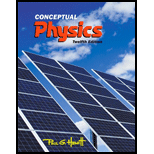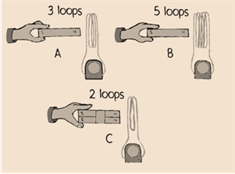
Conceptual Physics / MasteringPhysics (Book & Access Card)
12th Edition
ISBN: 9780321908605
Author: Paul G. Hewitt
Publisher: PEARSON
expand_more
expand_more
format_list_bulleted
Concept explainers
Question
Chapter 25, Problem 45RCQ
To determine
By ranking the reading on the galvanometer from greatest to least.

Expert Solution & Answer
Want to see the full answer?
Check out a sample textbook solution
Students have asked these similar questions
4.) The diagram shows the electric field lines of a positively charged conducting sphere of
radius R and charge Q.
A
B
Points A and B are located on the same field line.
A proton is placed at A and released from rest. The magnitude of the work done by the electric field in
moving the proton from A to B is 1.7×10-16 J. Point A is at a distance of 5.0×10-2m from the centre of
the sphere. Point B is at a distance of 1.0×10-1 m from the centre of the sphere.
(a) Explain why the electric potential decreases from A to B. [2]
(b) Draw, on the axes, the variation of electric potential V with distance r from the centre of the
sphere.
R
[2]
(c(i)) Calculate the electric potential difference between points A and B. [1]
(c(ii)) Determine the charge Q of the sphere. [2]
(d) The concept of potential is also used in the context of gravitational fields. Suggest why scientists
developed a common terminology to describe different types of fields. [1]
3.) The graph shows how current I varies with potential difference V across a component X.
904
80-
70-
60-
50-
I/MA
40-
30-
20-
10-
0+
0
0.5
1.0 1.5 2.0 2.5 3.0 3.5 4.0 4.5 5.0
VIV
Component X and a cell of negligible internal resistance are placed in a circuit.
A variable resistor R is connected in series with component X. The ammeter reads 20mA.
4.0V
4.0V
Component X and the cell are now placed in a potential divider circuit.
(a) Outline why component X is considered non-ohmic. [1]
(b(i)) Determine the resistance of the variable resistor. [3]
(b(ii)) Calculate the power dissipated in the circuit. [1]
(c(i)) State the range of current that the ammeter can measure as the slider S of the potential divider
is moved from Q to P. [1]
(c(ii)) Describe, by reference to your answer for (c)(i), the advantage of the potential divider
arrangement over the arrangement in (b).
1.) Two long parallel current-carrying wires P and Q are separated by 0.10 m. The current in wire P is 5.0 A.
The magnetic force on a length of 0.50 m of wire P due to the current in wire Q is 2.0 × 10-s N.
(a) State and explain the magnitude of the force on a length of 0.50 m of wire Q due to the current in P. [2]
(b) Calculate the current in wire Q. [2]
(c) Another current-carrying wire R is placed parallel to wires P and Q and halfway between them as shown.
wire P
wire R
wire Q
0.05 m
0.05 m
The net magnetic force on wire Q is now zero.
(c.i) State the direction of the current in R, relative to the current in P.[1]
(c.ii) Deduce the current in R. [2]
Chapter 25 Solutions
Conceptual Physics / MasteringPhysics (Book & Access Card)
Ch. 25 - Prob. 1RCQCh. 25 - What must change in order for electromagnetic...Ch. 25 - State Faraday’s law.Ch. 25 - What are the three ways in which voltage can be...Ch. 25 - How does the frequency of induced voltage relate...Ch. 25 - What are the basic differences and similarities...Ch. 25 - Prob. 7RCQCh. 25 - Prob. 8RCQCh. 25 - Prob. 9RCQCh. 25 - Prob. 10RCQ
Ch. 25 - What commonly supplies the energy input to a...Ch. 25 - Prob. 12RCQCh. 25 - Prob. 13RCQCh. 25 - Prob. 14RCQCh. 25 - Prob. 15RCQCh. 25 - Prob. 16RCQCh. 25 - Prob. 17RCQCh. 25 - Prob. 18RCQCh. 25 - Prob. 19RCQCh. 25 - In a step-down transformer, how does the input...Ch. 25 - Prob. 21RCQCh. 25 - Prob. 22RCQCh. 25 - When the magnetic field changes in a coil of wire,...Ch. 25 - Prob. 24RCQCh. 25 - Prob. 25RCQCh. 25 - Prob. 26RCQCh. 25 - What is induced by the rapid alternation of a...Ch. 25 - What is induced by the rapid alternation of an...Ch. 25 - Prob. 29RCQCh. 25 - Prob. 30RCQCh. 25 - Prob. 31RCQCh. 25 - Prob. 32RCQCh. 25 - Prob. 33RCQCh. 25 - Prob. 34RCQCh. 25 - 35. The primary of a transformer connected to 120...Ch. 25 - 36. The primary of a transformer connected to 120...Ch. 25 - Prob. 37RCQCh. 25 - 38. A model electric train requires 6 V to...Ch. 25 - Prob. 39RCQCh. 25 - Prob. 40RCQCh. 25 - Prob. 41RCQCh. 25 - 42. An ideal transformer has 50 turns in its...Ch. 25 - Prob. 43RCQCh. 25 - 44. A power of 100 kW (105 W) is delivered to the...Ch. 25 - 45. Bar magnets are moved into the wire coils in...Ch. 25 - 46. Each of the transformers shown is powered with...Ch. 25 - Prob. 47RCQCh. 25 - Prob. 48RCQCh. 25 - Prob. 49RCQCh. 25 - Prob. 50RCQCh. 25 - Prob. 51RCQCh. 25 - 52. Why does a motor also tend to act as a...Ch. 25 - Prob. 53RCQCh. 25 - Prob. 54RCQCh. 25 - Prob. 55RCQCh. 25 - Prob. 56RCQCh. 25 - Prob. 57RCQCh. 25 - 58. When you turn the shaft of an electric motor...Ch. 25 - Prob. 59RCQCh. 25 - Does the voltage output increase when a generator...Ch. 25 - Prob. 61RCQCh. 25 - Prob. 62RCQCh. 25 - Prob. 63RCQCh. 25 - 64. How could a lightbulb near an electromagnet,...Ch. 25 - 65. A length of wire is bent into a closed loop...Ch. 25 - 66. Two separate but similar coils of wire are...Ch. 25 - Prob. 67RCQCh. 25 - Prob. 68RCQCh. 25 - Prob. 69RCQCh. 25 - Prob. 70RCQCh. 25 - Prob. 71RCQCh. 25 - Prob. 72RCQCh. 25 - Prob. 73RCQCh. 25 - Prob. 74RCQCh. 25 - Prob. 75RCQCh. 25 - 76. A 120-V ac source powers the circuit shown....Ch. 25 - 77. In the circuit shown, how many volts are...Ch. 25 - Prob. 78RCQCh. 25 - Prob. 79RCQCh. 25 - Prob. 80RCQCh. 25 - Prob. 81RCQCh. 25 - Prob. 82RCQCh. 25 - Prob. 83RCQCh. 25 - 84. How do you suppose the frequency of an...Ch. 25 - Prob. 85RCQCh. 25 - Prob. 86RCQCh. 25 - Prob. 87RCQCh. 25 - Prob. 88RCQCh. 25 - Prob. 89RCQCh. 25 - 90. Your friend says that according to Ohm’s law,...Ch. 25 - Prob. 91RCQCh. 25 - Prob. 92RCQCh. 25 - Prob. 93RCQCh. 25 - 94. A metal bar, pivoted at one end, oscillates...Ch. 25 - Prob. 95RCQCh. 25 - Prob. 96RCQ
Knowledge Booster
Learn more about
Need a deep-dive on the concept behind this application? Look no further. Learn more about this topic, physics and related others by exploring similar questions and additional content below.Similar questions
- 2.) A 50.0 resistor is connected to a cell of emf 3.00 V. The voltmeter and the ammeter in the circuit are ideal. V A 50.00 (a) The current in the ammeter is 59.0 mA. Calculate the internal resistance of the cell. The circuit is changed by connecting another resistor R in parallel to the 50.0 resistor. V A 50.00 R (b) Explain the effect of this change on R is made of a resistive wire of uniform cross-sectional area 3.1 × 10-8 m², resistivity 4.9 × 10-70m and length L. The resistance of R is given by the equation R = KL where k is a constant. (b.i) the reading of the ammeter. [2] (b.ii) the reading of the voltmeter. [2] (c) Calculate k. State an appropriate unit for your answer. [3] [2]arrow_forwardNo chatgpt pls will upvotearrow_forwardNo chatgpt pls will upvotearrow_forward
- A rod 12.0 cm long is uniformly charged and has a total charge of -20.0 μc. Determine the magnitude and direction of the electric field along the axis of the rod at a point 32.0 cm from its center. 361000 ☑ magnitude What is the general expression for the electric field along the axis of a uniform rod? N/C direction toward the rodarrow_forwardA certain brand of freezer is advertised to use 730 kW h of energy per year. Part A Assuming the freezer operates for 5 hours each day, how much power does it require while operating? Express your answer in watts. ΜΕ ΑΣΦ ? P Submit Request Answer Part B W If the freezer keeps its interior at a temperature of -6.0° C in a 20.0° C room, what is its theoretical maximum performance coefficient? Enter your answer numerically. K = ΜΕ ΑΣΦ Submit Request Answer Part C What is the theoretical maximum amount of ice this freezer could make in an hour, starting with water at 20.0°C? Express your answer in kilograms. m = Ο ΑΣΦ kgarrow_forwardDescribe the development of rational choice theory in sociology. Please includearrow_forward
- A-E pleasearrow_forwardA 11.8 L gas tank containing 3.90 moles of ideal He gas at 26.0°C is placed inside a completely evacuated insulated bell jar of volume 39.0 L .A small hole in the tank allows the He to leak out into the jar until the gas reaches a final equilibrium state with no more leakage. Part A What is the change in entropy of this system due to the leaking of the gas? ■ ΜΕ ΑΣΦ AS = ? J/K Submit Request Answer Part B Is the process reversible or irreversible?arrow_forwardA-E pleasearrow_forward
- Three moles of an ideal gas undergo a reversible isothermal compression at 20.0° C. During this compression, 1900 J of work is done on the gas. For related problem-solving tips and strategies, you may want to view a Video Tutor Solution of Entropy change in a free expansion. Part A What is the change of entropy of the gas? ΤΕ ΑΣΦ AS = Submit Request Answer J/Karrow_forward5.97 Block A, with weight 3w, slides down an inclined plane S of slope angle 36.9° at a constant speed while plank B, with weight w, rests on top of A. The plank is attached by a cord to the wall (Fig. P5.97). (a) Draw a diagram of all the forces acting on block A. (b) If the coefficient of kinetic friction is the same between A and B and between S and A, determine its value. Figure P5.97 B A S 36.9°arrow_forwardPlease take your time and solve each part correctly please. Thank you!!arrow_forward
arrow_back_ios
SEE MORE QUESTIONS
arrow_forward_ios
Recommended textbooks for you
 College PhysicsPhysicsISBN:9781305952300Author:Raymond A. Serway, Chris VuillePublisher:Cengage Learning
College PhysicsPhysicsISBN:9781305952300Author:Raymond A. Serway, Chris VuillePublisher:Cengage Learning University Physics (14th Edition)PhysicsISBN:9780133969290Author:Hugh D. Young, Roger A. FreedmanPublisher:PEARSON
University Physics (14th Edition)PhysicsISBN:9780133969290Author:Hugh D. Young, Roger A. FreedmanPublisher:PEARSON Introduction To Quantum MechanicsPhysicsISBN:9781107189638Author:Griffiths, David J., Schroeter, Darrell F.Publisher:Cambridge University Press
Introduction To Quantum MechanicsPhysicsISBN:9781107189638Author:Griffiths, David J., Schroeter, Darrell F.Publisher:Cambridge University Press Physics for Scientists and EngineersPhysicsISBN:9781337553278Author:Raymond A. Serway, John W. JewettPublisher:Cengage Learning
Physics for Scientists and EngineersPhysicsISBN:9781337553278Author:Raymond A. Serway, John W. JewettPublisher:Cengage Learning Lecture- Tutorials for Introductory AstronomyPhysicsISBN:9780321820464Author:Edward E. Prather, Tim P. Slater, Jeff P. Adams, Gina BrissendenPublisher:Addison-Wesley
Lecture- Tutorials for Introductory AstronomyPhysicsISBN:9780321820464Author:Edward E. Prather, Tim P. Slater, Jeff P. Adams, Gina BrissendenPublisher:Addison-Wesley College Physics: A Strategic Approach (4th Editio...PhysicsISBN:9780134609034Author:Randall D. Knight (Professor Emeritus), Brian Jones, Stuart FieldPublisher:PEARSON
College Physics: A Strategic Approach (4th Editio...PhysicsISBN:9780134609034Author:Randall D. Knight (Professor Emeritus), Brian Jones, Stuart FieldPublisher:PEARSON

College Physics
Physics
ISBN:9781305952300
Author:Raymond A. Serway, Chris Vuille
Publisher:Cengage Learning

University Physics (14th Edition)
Physics
ISBN:9780133969290
Author:Hugh D. Young, Roger A. Freedman
Publisher:PEARSON

Introduction To Quantum Mechanics
Physics
ISBN:9781107189638
Author:Griffiths, David J., Schroeter, Darrell F.
Publisher:Cambridge University Press

Physics for Scientists and Engineers
Physics
ISBN:9781337553278
Author:Raymond A. Serway, John W. Jewett
Publisher:Cengage Learning

Lecture- Tutorials for Introductory Astronomy
Physics
ISBN:9780321820464
Author:Edward E. Prather, Tim P. Slater, Jeff P. Adams, Gina Brissenden
Publisher:Addison-Wesley

College Physics: A Strategic Approach (4th Editio...
Physics
ISBN:9780134609034
Author:Randall D. Knight (Professor Emeritus), Brian Jones, Stuart Field
Publisher:PEARSON
Magnets and Magnetic Fields; Author: Professor Dave explains;https://www.youtube.com/watch?v=IgtIdttfGVw;License: Standard YouTube License, CC-BY